




|
Origami Animals
This is the largest section of diagrams on the site. The animal kingdom represents a fascinating topic to fold models from. Below are a selection of models including some of my earliest designs and a few thoughts and ruminations about them. Click on the model name or the picture to load the diagrams.
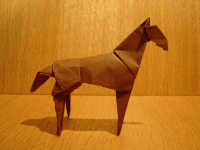
|
I have designed this closed back horse to try to make maximum use of the paper, without becoming too complex. Having seen
Robert Lang design a stallion with the tail not located at a corner or edge, I felt I'd take a similar approach. The model
has nice long limbs and can be wetfolded. The folds shaping the head can be quite variable, and may need a few attempts.
|
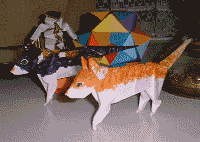
|
Following on from the fat cat comes this slightly thinner design. This uses a Montroll style base to create all the flaps. These particular models are my attempt to fold Mabel and George, two of my greatest critics.
|
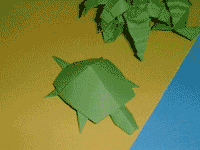
|
This is a fairly simple model that produces an attractive finish. The shell area is fairly large, and I prefer to add a few crimps at the end to give it a rounded feel. This model can look very nice if folded from textured paper, which can be found in some art shops.
|
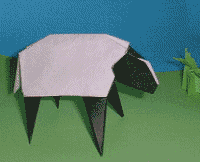
|
Here is a two-tone sheep. Using a black sheet of paper, you can make the legs and head a different colour. I think the breed is a Derbyshire sheep, but I'm not an expert. Any Welshmen / New Zealanders reading?
|

|
I tried to find a base that isnt used very much for four legged creations, and came across this variation of a Water Bomb Base. An unused fold lies in the middle of the model and the model has an open back. This is one of my older creations and most of my new work uses a 'closed back' method to give it a more lifelike appearence.
|
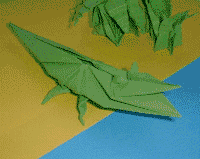
|
This model is best folded with an all green sheet of paper. If you do use traditional origami paper, try not to make the fold in step 7 too sharp or you will end up with a white stripe down the models back! 'George' is the name of a soft toy crocodile belonging to my Brother's wife, to whom this model is dedicated.
|
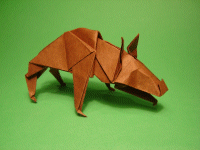 |
The Hyena is a dog like beast known for its scavenging habits and laughing cackle of a call. It is actually more closely related to a bear than canines. This model was originally called 'Jackel' until I looked in a Zoology book, and saw that I'd got the names mixed up :-) As the model looks in these diagrams, the head is rather large; you may wish to shape it further.
|
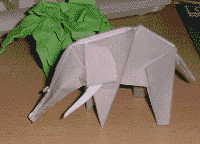
|
This elephant manages to have a rather nice 3D look about it which this photo does not fully show off. If you fold all the steps correctly, the tusks will be a different colour to the rest of the model (providing you use two-tone paper, of course!)
|
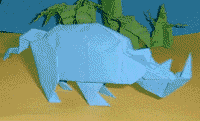
|
This model was developed as a result of a request on the Origami mailing list and was hastily diagrammed. I have recieved plenty of e-mails asking quite how to do step 11. Going back to the diagrams I can honsestly say that I've got no idea. So good luck, you'll need it! Inserting your finger inside the model and crumpling some of the paper seems to be the best way to do it. This model has been used in an ad campaign for Fisherman's Friend throat sweets.
|
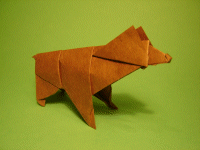
|
A 'Pureland' model is one formed using only mountain and valley folds. It is rather a challenge to produce recognisable four legged animals this way. This bear is one of the easiest models on this page.
|
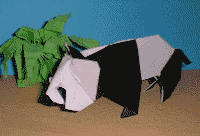
|
This is another two-tone model and can be folded from a black sheet of origami paper. I rather like the tired looking expression that this model can capture. Be careful not to make the head too big! Note - these diagrams need to be re-scanned. Apologies for the missing text at the bottom of page 2. This should read 'fold flaps down and squash fold layers underneath'.
Difficulty ***
|
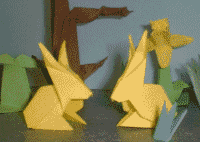
|
This rabbit is one of my favorite models. It is simple, quick to fold and looks very cute. It is folded from a traditional 'windmill' base. This design owes a lot to the origami of Kunihiko Kasahara, one of the best designers of simple models there is.
|
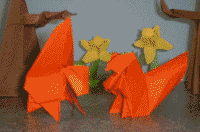
|
This design came to me in a flash as I was looking for simple designs from a fish base. Although it has only a few folds, it creates a four-limbed animal with 3D features and a seamless closed back. I taught this model at the BOS spring conference in Cambridge, and the design seemed to go down pretty well.
|
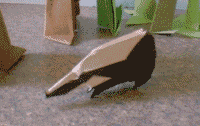
|
This was one of my first ever designs and I wanted to create a two tone model with a nice 3D feel to it. Although there is rather too much white in the back, the design has a nice shape and a straight-forward folding sequence.
|
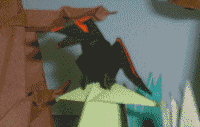
|
This crow uses a base attributed to Jun Maekawa. I used it to create a model that could pertch properly, for example on the edge of a beer glass. If you use two-tone paper, the model has different coloured eyes - red in the case of the model on the left.
|
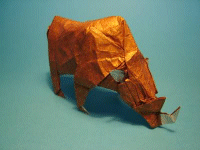
|
This rhino uses a rather open crease pattern to allow for maximum use of the paper. I have tried to capture the bulky shoulders and large ears of this creature, as well as leaving enough paper left over for facial features. The model can be folded with single colour paper if a more traditional rhino is required.
|
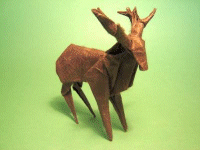
|
Bushy Park is a royal park closed to where I like. King Henry VIII used to hunt deer there. This model was designed while watching the descendants of those very stags (well, the ones that got away). Most of the bulk of the model is hidden in the neck and shoulders, so use thin paper, or wetfold, otherwise the model can become too bulky.
|
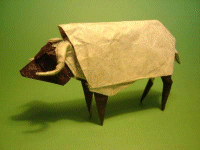
|
This model was designed while on holiday in Scotland. Care is needed in manipulating the horns and ears to the correct positions, and the crease down the back of the model should be made as softly as possible to allow for 3D folding.
|
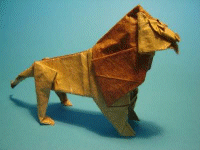
|
This model uses the edge of the paper to create a colour change. The lion is named 'Leo the lion', not because of the obvious alliteration, but after a doctor I worked with called 'Leo'. He used to inspect all of my creations and make a comment along the lines of 'Well, it is nice, but you cannot tell if it is a boy or a girl'. If folded properly, this lion will be... erm... anatomically correct.
|
|







































































